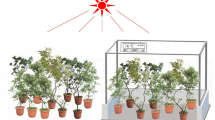Abstract
The population of saprotrophic, oligotrophic, and nitrogen-fixing microorganisms was determined in cryogenic forest soils of central Yakutia. The number of saprotrophic bacteria ranged between 108 and 1010 cell/g of soil. In the soils of Buryatia, this parameter (108) was 4 orders of magnitude as high as in the soils of European Russia (106). According to the increase in the total number of microorganisms in the soils studied, the forests were arranged in the following sequence: pine forest—birch forest—larch forest. The main factor that determined the saturation of the studied frozen soils with microorganisms was the landscape, i.e., the forest type and the soil type. Of minor importance were the weather conditions of the year or season investigated, which defined the intra-and interspecies variation of the total population of the soil microorganisms.
Similar content being viewed by others
References
L. G. Elovskaya, Classification and Diagnostics of Frozen Soils in Yakutia (Akad. Nauk SSSR, Yakutsk, 1987) [in Russian].
D. G. Zvyagintsev, Soil and Microorganisms (Mosk. Gos. Univ., Moscow, 1987) [in Russian].
D. G. Zvyagintsev, T. G. Dobrovol’skaya, I. Yu. Chernov, et al., “The Particularities of Taxonomic Composition of Microbial Complexes in the Soils of Baikal Region,” Pochvovedenie, No. 6, 727–731 (1999) [Eur. Soil Sci. 32 (6), 659–663 (1999)].
V. G. Zol’nikov, “Soils of the Eastern Regions of Central Yakutia and Their Use,” in Natural Conditions and Agriculture of Central Yakutia (Akad. Nauk SSSR, Moscow, 1954), pp. 55–221 [in Russian].
T. I. Ivanova, “Microbiological Study of Sapropels in the Cryolithozone,” Nauka Obrazov. (Yakutsk), No. 1, 39–43 (1998).
Classification System of Russian Soils (Moscow, 2000) [in Russian].
I. A. Mazilkin, “Microbiological Characterization of Soddy-Forest and Humus-Calcareous Soils in the Olekminsk Region of Yakut ASSR,” in Natural Conditions and Agriculture in the Southwestern Regions of Yakut ASSR (Akad. Nauk SSSR, Moscow, 1956), pp. 135–176 [in Russian].
Methods of Soil Microbiology and Biochemistry, Ed. by D. G. Zvyagintsev (Mosk. Gos. Univ., Moscow, 1991) [in Russian].
Laboratory Manual of Microbiology, Ed. by N. S. Egorov (Mosk. Gos. Univ., Moscow, 1976) [in Russian].
S. M. Semenov, Laboratory Media for Actinomycetes and Fungi (Moscow, 1990) [in Russian].
T. F. Chernyakovskaya, T. G. Dobrovol’skaya, L. V. Lysak, and S. A. Vanina, “Distribution of Epiphytic and Saprotrophic Bacteria among the Components of Vertical Structure in Steppe Biogeocenoses,” Pochvovedenie, No. 6, 68–77 (1990).
Author information
Authors and Affiliations
Additional information
Original Russian Text © T.I. Ivanova, N.P. Kononova, N.V. Nikolaeva, A.P. Chevychelov, 2006, published in Pochvovedenie, 2006, No. 6, pp. 735–740.
Rights and permissions
About this article
Cite this article
Ivanova, T.I., Kononova, N.P., Nikolaeva, N.V. et al. Microorganisms in forest soils of central Yakutia. Eurasian Soil Sc. 39, 661–666 (2006). https://doi.org/10.1134/S1064229306060111
Received:
Issue Date:
DOI: https://doi.org/10.1134/S1064229306060111




